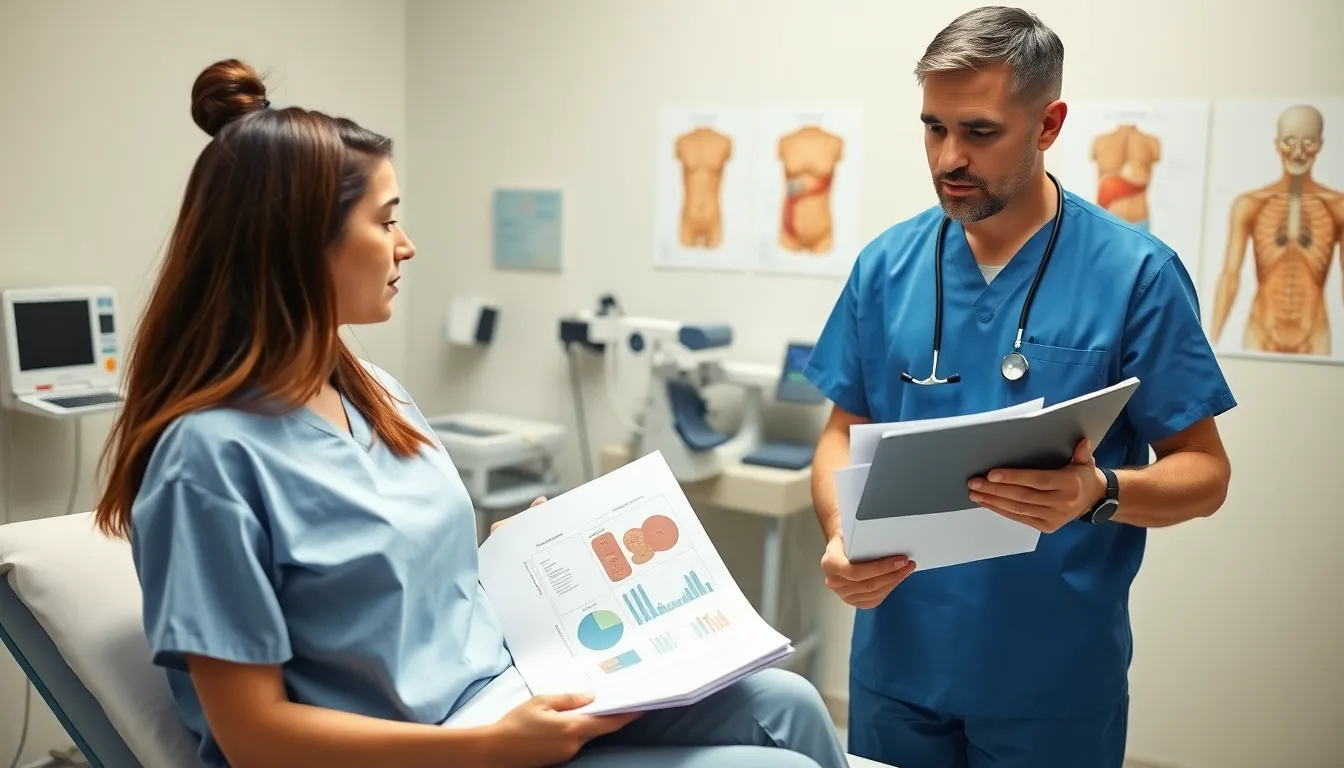Lower abdominal pain can be a perplexing symptom, affecting individuals in various ways. Understanding its underlying causes is crucial for effective diagnosis and treatment. The International Classification of Diseases, Tenth Revision (ICD-10) provides a standardized coding system that helps healthcare professionals categorize this type of pain accurately.
By familiarizing themselves with the relevant ICD-10 codes, patients and providers can communicate more effectively about symptoms and potential conditions. This article delves into the specifics of lower abdominal pain as classified in the ICD-10, offering insights into common diagnoses and their implications. Whether it’s a mild discomfort or a sign of something more serious, knowing the right codes can make all the difference in navigating healthcare.
Table of Contents
ToggleOverview of Lower Abdominal Pain
Lower abdominal pain refers to discomfort located between the chest and groin, specifically affecting the area below the belly button. This pain can stem from various conditions involving organs such as the intestines, bladder, or reproductive organs. Identifying the underlying cause is crucial for effective treatment.
Common causes of lower abdominal pain include:
- Appendicitis: Inflammation of the appendix, often causing sharp pain in the lower right abdomen.
- Diverticulitis: Inflammation or infection of pouches in the colon, resulting in pain typically on the lower left side.
- Ovarian cysts: Fluid-filled sacs on the ovaries that can cause sharp or dull pain.
- Ectopic pregnancy: A pregnancy occurring outside the uterus, leading to severe pain and potential complications.
- Urinary tract infections (UTIs): Infections affecting the bladder or urethra, causing pain in the lower abdomen.
ICD-10 categorizes lower abdominal pain using several codes to assist in the diagnosis framework, facilitating clearer communication among healthcare providers. Detecting the correct ICD-10 code, such as R10.30 (lower abdominal pain, unspecified), enables accurate classification and helps guide treatment strategies. Proper coding simplifies healthcare navigation while ensuring both patients and providers have a mutual understanding of the condition.
Understanding ICD-10 Classification

ICD-10, or the International Classification of Diseases, Tenth Revision, serves as a coding system for diagnosing various health conditions, including lower abdominal pain. This classification enhances communication and promotes standardized care across healthcare settings.
What is ICD-10?
ICD-10 comprises a comprehensive set of codes used by healthcare professionals to identify and categorize diseases and health-related issues. It integrates both an alphanumeric coding system and a detailed framework covering multiple medical disciplines. ICD-10 includes approximately 70,000 codes, which allow for precise descriptions of patient diagnoses, symptoms, and procedures. This specificity aids in tracking epidemiological data and allocating healthcare resources effectively.
Importance of ICD-10 for Lower Abdominal Pain
ICD-10 plays a crucial role in classifying lower abdominal pain due to its ability to provide precise diagnostic codes, such as R10.30 for unspecified lower abdominal pain. Accurate coding directly influences treatment approaches, insurance reimbursements, and patient records. By utilizing specific ICD-10 codes, healthcare providers can convey essential information to ensure appropriate management of conditions leading to lower abdominal pain. Improved coding accuracy enhances patient care, streamlines medical billing processes, and supports research initiatives focused on effective treatments.
Common Causes of Lower Abdominal Pain
Lower abdominal pain can stem from various medical conditions. Understanding these common causes aids healthcare professionals in addressing patient concerns effectively.
Digestive Disorders
Digestive disorders often lead to lower abdominal pain. Conditions include:
- Appendicitis: Involves inflammation of the appendix, causing sharp pain in the lower right abdomen.
- Diverticulitis: Occurs when diverticula become inflamed or infected, typically resulting in pain on the left side.
- Irritable Bowel Syndrome (IBS): Characterized by cramping, bloating, and changes in bowel habits, causing intermittent pain.
- Gastroenteritis: An inflammation of the stomach and intestines leading to cramping and pain, along with nausea and diarrhea.
Gynecological Issues
Gynecological issues frequently present as lower abdominal pain in females. Relevant conditions include:
- Ovarian Cysts: Fluid-filled sacs on the ovaries that may cause sharp, localized pain if they rupture.
- Ectopic Pregnancy: Occurs when a fertilized egg implants outside the uterus, leading to severe and sudden pain.
- Pelvic Inflammatory Disease (PID): An infection of the female reproductive organs often causing dull or sharp abdominal pain.
- Menstrual Cramps: Common during menstruation, these cramps can result in pain localized in the lower abdomen.
Urinary Tract Problems
Urinary tract problems frequently contribute to lower abdominal pain. Conditions include:
- Urinary Tract Infections (UTIs): Can cause painful urination and discomfort in the lower abdomen.
- Kidney Stones: Hard deposits that can form in the kidneys, causing severe pain when passing through the urinary tract.
- Bladder Infections: Inflammation of the bladder leading to pain, pressure, and frequent urges to urinate.
- Interstitial Cystitis: A chronic condition causing bladder pressure and pain, typically worsening when the bladder fills.
Understanding these causes allows healthcare providers to apply appropriate ICD-10 codes and manage treatments effectively.
Diagnosing Lower Abdominal Pain
Diagnosing lower abdominal pain involves a thorough assessment of medical history and symptoms, coupled with specific diagnostic tests and procedures. This comprehensive approach enables healthcare providers to identify underlying causes accurately.
Role of Medical History and Symptoms
Medical history plays a crucial role in diagnosing lower abdominal pain. Providers gather details about the patient’s past health, including previous illnesses, surgeries, and family history of gastrointestinal or reproductive conditions. Symptoms reported by patients, such as the nature and duration of pain, associated symptoms like nausea or fever, and any changes in bowel habits, guide providers toward possible diagnoses. For instance, sharp pain with fever may indicate appendicitis, while dull, chronic pain could suggest irritable bowel syndrome (IBS). This information forms the foundation for selecting appropriate diagnostic tests and applying relevant ICD-10 codes.
Diagnostic Tests and Procedures
Diagnostic tests and procedures are essential for pinpointing the cause of lower abdominal pain. Common tests include:
- Blood tests: Identify infections, inflammation markers, and organ function.
- Urinalysis: Detect urinary tract infections and kidney issues.
- Imaging tests: Include abdominal ultrasound, CT scans, and X-rays to visualize internal structures and diagnose conditions like appendicitis, ovarian cysts, or diverticulitis.
- Endoscopy: Involves inserting a flexible tube with a camera into the digestive tract for direct visualization of abnormalities.
Each test provides valuable insights that, when combined with medical history and symptom assessments, lead to accurate diagnoses and effective treatment plans. Accurate coding with ICD-10 ensures that the findings and treatments align with standardized healthcare protocols.
Treatment Options for Lower Abdominal Pain
Treatment for lower abdominal pain varies based on the underlying cause and severity. Healthcare providers recommend a combination of medication and surgical interventions to address specific conditions.
Medications
Medications play a crucial role in managing lower abdominal pain. Healthcare providers often prescribe:
- Analgesics: These relieve pain and can include non-steroidal anti-inflammatory drugs (NSAIDs) like ibuprofen or naproxen.
- Antibiotics: For infections such as urinary tract infections or diverticulitis, antibiotics address bacterial causes effectively.
- Antispasmodics: These target muscle spasms in conditions like irritable bowel syndrome (IBS), providing relief from cramping.
- Hormonal treatments: For gynecological issues such as ovarian cysts or endometriosis, hormonal medications manage pain by regulating menstrual cycles.
These medications target specific conditions associated with lower abdominal pain, enhancing patient comfort during recovery.
Surgical Interventions
Surgical interventions may become necessary when conservative treatments fail or when a diagnosis indicates a surgical solution. Common surgical options include:
- Appendectomy: This procedure removes the appendix in cases of appendicitis, alleviating pain and preventing complications.
- Oophorectomy: This surgery removes ovarian cysts or affected ovaries, addressing persistent gynecological pain.
- Laparoscopic surgery: Utilizing minimally invasive techniques, surgeons can identify and treat conditions such as pelvic inflammatory disease or endometriosis.
- Bowel resection: For severe cases of diverticulitis or bowel obstructions, surgeons may remove damaged sections of the intestine.
Surgical options aim to resolve the underlying issue causing lower abdominal pain, improving patient outcomes and quality of life.
Understanding lower abdominal pain and its ICD-10 classifications is crucial for effective diagnosis and treatment. By recognizing the various causes and utilizing the appropriate codes healthcare providers can enhance communication and streamline care. This not only aids in accurate treatment plans but also supports insurance processes and patient records.
As patients navigate their healthcare journeys awareness of ICD-10 codes related to lower abdominal pain empowers them to engage more effectively with their providers. Ultimately this knowledge fosters better health outcomes and a deeper understanding of the underlying issues contributing to discomfort.


